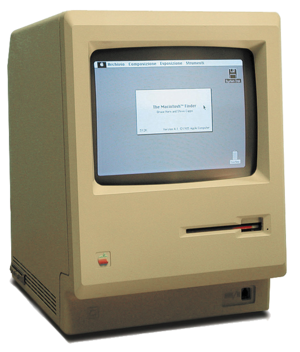Macintosh 128k
 |
|
| Also known as | Apple Macintosh |
|---|---|
| Developer | Apple Computer, Inc. |
| Product family | Macintosh |
| Release date | January 24, 1984 |
| Introductory price | US$2,495 (equivalent to $5,752 in 2016) |
| Discontinued | October 1, 1985 |
| Operating system | System Software 1.0 |
| CPU | Motorola 68000 @ 7.8336 MHz (6 MHz effectively) |
| Memory | 128 KB RAM (built-in) |
| Predecessor | Apple Lisa, Lisa II |
| Successor | Macintosh 512K |
The Macintosh 128K, originally released as the Apple Macintosh, is the original Apple Macintosh personal computer. Its beige case consisted of a 9 in (23 cm) CRT monitor and came with a keyboard and mouse. A handle built into the top of the case made it easier for the computer to be lifted and carried. It had an initial selling price of $2,495 (equivalent to $5,752 in 2016). The Macintosh was introduced by the now-famous $370,000 (equivalent to $852,944 in 2016) television commercial by Ridley Scott, "1984", that most notably aired on CBS during the third quarter of Super Bowl XVIII on January 22, 1984. Sales of the Macintosh were strong from its initial release on January 24, 1984, and reached 70,000 units on May 3, 1984. Upon the release of its successor, the Macintosh 512K, it was rebranded as the Macintosh 128K.
The centerpiece of the machine was a Motorola 68000 microprocessor running at 7.8336 MHz, connected to 128 KB RAM shared by the processor and the display controller. The boot procedure and some operating system routines were contained in an additional 64 KB ROM chip. Apple did not offer RAM upgrades. Unlike the Apple II, no source code listings of the Macintosh system ROMs were offered.
The RAM in the Macintosh consisted of sixteen 4164 64kx1 DRAMs.
The 68000 and video controller took turns accessing DRAM every four CPU cycles during display of the frame buffer, while the 68000 had unrestricted access to DRAM during vertical and horizontal blanking intervals. Such an arrangement reduced the overall performance of the CPU as much as 35% for most code as the display logic often blocked the CPU's access to RAM. This made the machine appear to run more slowly than several of its competitors, despite the nominally high clock rate.
The built-in display was a one-bit black-and-white, 9 in (23 cm) CRT with a fixed resolution of 512×342 pixels, establishing the desktop publishing standard of 72 PPI. Expansion and networking were achieved using two non-standard RS-422 DE-9 serial ports named "printer" and "modem"; they did not support hardware handshaking. An external floppy disk drive could be added using a proprietary connector (19-pin D-sub). The keyboard and mouse used simple proprietary protocols, allowing some third-party upgrades. The original keyboard had no arrow keys, numeric keypad or function keys. This was an intentional decision by Apple, as these keys were common on older platforms and it was thought that the addition of these keys would encourage software developers to simply port their existing applications to the Mac, rather than design new ones around the GUI paradigm. Later, Apple would make a numeric keypad available for the Macintosh 128K. The keyboard sold with the newer Macintosh Plus model would include the numeric keypad and arrow keys, but still no function keys. As with the Apple Lisa before it, the mouse had a single button. Standard headphones could also be connected to a monaural jack. Apple also offered their 300 and 1200 bit/s modems originally released for the Apple II line. Initially, the only printer available was the Apple ImageWriter, a dot matrix printer which was designed to produce 144 dpi WYSIWYG output from the Mac's 72 dpi screen. Eventually, the LaserWriter and other printers were capable of being connected using AppleTalk, Apple's built-in networking system.
...
Wikipedia
